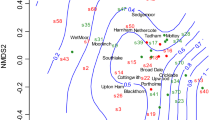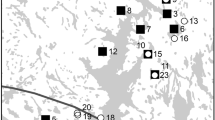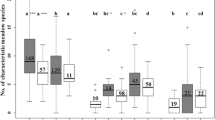Abstract
Biotas of both geographical islands and habitat islands are often nested subsets of the biotas of successively more species-rich islands within the same system. The life history characteristics of a species may determine how that species contributes to the general pattern of species nestedness. Here, I investigate the floras of 56 sedge meadow wetlands in northern Illinois (USA) in order to characterize the degree of nestedness in these communities, determine which individual plant species contribute to the nested pattern, and investigate species characteristics that might be related to nonrandom patterns of distribution in individual plant species. The entire assemblage of species at all sedge meadows was significantly nested. Species richness and area were significantly correlated, and the nested pattern was closely related to site area, suggesting that species drop out of the assemblage in a predictable order as site area decreases. Some individual species exhibited nonrandom distributions across the sites, occurring more often in large, species-rich sites. Large sites were more likely than smaller sites to contain conservative species, i.e., those typical of pristine natural habitat, whereas nonconservative species were distributed more randomly among sites. Nested patterns of distribution of conservative species with respect to site area may result from their high probability of extinction on small sites or from a tendency for required habitats to co-occur on the same large sites.
Similar content being viewed by others
References
Analytical Software. 2000. Statistix for Windows user's manual, Version 2.2. Analytical Software, Tallahassee, Florida, USA.
Atmar W. and Patterson B.D. 1993. The measure of order and disorder in the distribution of species in fragmented habitat. Oecologia 96: 373–382.
Atmar W. and Patterson B.D. 1995. The Nestedness Temperature Calculator, a visual BASIC program, including 294 presence-absence matrices. AICS Research Inc., University Park, New Mexico, USA and the Field Museum, Chicago, Illinois, USA.
Blake J.G. 1991. Nested subsets and the distribution of birds on isolated woodlots. Conservation Biology 5: 58–66.
Boecklen W.J. 1997. Nestedness, biogeographic theory, and the design of nature reserves. Oecologia 112: 123–142.
Bolger D.T. Alberts A.C. and Soulé M.E. 1991. Occurrence patterns of bird species in habitat fragments: sampling, extinction, and nested species subsets. American Naturalist 137: 155–166.
Brown J.H. and Kodric-Brown A. 1977. Turnover rates in insular biogeography: effect of immigration on extinction. Ecology 58: 445–449.
Butaye J., Jacquemyn H. and Hermy M. 2001. Differential colonization causing non-random forest plant community structure in a fragmented agricultural landscape. Ecography 24: 369–380.
Butaye J., Jacquemyn H., Honnay O. and Hermy M. 2002. The species pool concept applied to forests in a fragmented landscape: dispersal limitation versus habitat limitation. Journal of Vegetation Science 13: 27–34.
Cook R.R. 1995. The relationship between nested subsets, habitat subdivision, and species diversity. Oecologia 101: 204–210.
Cook R.R. and Quinn J.F. 1995. The influence of colonization in nested species subsets. Oecologia 102: 413–424.
Cutler A. 1991. Nested faunas and extinction in fragmented habitats. Conservation Biology 5: 496–505.
Diamond J.M. 1972. Biogeographic kinetics: estimation of relaxation times for avifaunas of southwest Pacific islands. Proceedings of the National Academy of Science, USA 69: 3199–3203.
Ehrlén J. and Eriksson O. 2000. Dispersal limitation and patch occupancy in forest herbs. Ecology 81: 1667–1674.
Environmental Laboratory. 1987. Corps of Engineers wetlands delineation manual. U.S. Army Corps of Engineers Waterways Experimental Station, Vicksburg, Mississippi, USA. Technical Report Y-87-1.
Eriksson O. 1996. Regional dynamics of plants: a review of evidence for remnant, source-sink and metapopulations. Oikos 77: 248–258.
Gleason H. A. and Cronquist A. 1963. Manual of vascular plants of north-eastern United States and adjacent Canada. Van Nostrand Reinhold Co., New York, New York, USA.
Hecnar S.J. and M'Closkey R.T. 1997. Patterns of nestedness and species association in a pond-dwelling amphibian fauna. Oikos 80: 371–381.
Honnay O., Hermy M. and Coppin P. 1999. Nested plant communities in deciduous forest fragments: species relaxation or nested habitats. Oikos 84: 119–129.
Honnay O., Bossuyt B., Verheyen K., Butaye J., Jacquemyn H., and Hermy M. 2002. Ecological perspectives for the restoration of plant communities in European temperate forests. Biodiversity and Conservation 11: 213–242.
Iverson L.R., Ketzner D. and Karnes J. 1999. Illinois Plant Information Network. Database at http://www.fs.fed.us/ne/delaware/ilpin.html. Illinois Natural History Survey and USDA Forest Service.
Kadmon R. 1995. Nested species subsets and geographic isolation: a case study. Ecology 76: 458–465.
Kodric-Brown A. and Brown J.H. 1993. Highly structured fish communities in Australian desert springs. Ecology 74: 1847–1855.
Levin D.A. and Clay K. 1984. Dynamics of synthetic Phlox drum-mondii populations at the species margin. American Journal of Botany 71: 1040–1050.
Lomolino M.V. 1996. Investigating causality of nestedness of insular communities: selective immigrations or extinctions? Journal of Biogeography 23: 699–703.
MacArthur R.H. and Wilson E.O. 1967. The theory of island biogeography. Princeton University Press, Princeton, New Jersey, USA.
Matlack G.R. 1994. Plant species migration in a mixed-history forest landscape in eastern North America. Ecology 75: 1491–1502.
Millien-Para V. and Loreau M. 2000. Community composition and size structure of murid rodents in relation to the biogeography of the Japanese archipelago. Ecography 23: 413–423.
Mohlenbrock R.H. 1986. Guide to the vascular flora of Illinois. Revised and enlarged ed. Southern Illinois University Press, Carbondale, Illinois, USA.
Newmark W.D. 1987. A land-bridge island perspective on mammalian extinctions in western North American parks. Nature 325: 430–432.
Patterson B.D. 1987. The principle of nested subsets and its implications for biological conservation. Conservation Biology 1: 323–334.
Patterson B.D. 1990. On the temporal development of nested subset patterns of species composition. Oikos 59: 330–342.
Patterson B.D. and Atmar W. 1986. Nested subsets and the structure of insular mammalian faunas and archipelagos. Biological Journal of the Linnean Society 28: 65–82.
Perneger T.V. 1998. What's wrong with Bonferroni adjustments. British Medical Journal 316: 1236–1238.
Reed P.B., Jr. 1988. National list of plant species that occur in wetlands: Illinois. U.S. Department of the Interior, Fish and Wild-life Service, National Wetlands Inventory. NERC-88/18.13.
Rees M. 1993. Trade-offs among dispersal strategies in British plants. Nature 366: 150–152.
Rydin H. and Borgegård S.-O. 1991. Plant characteristics over a century of primary succession on islands: Lake Hjälmaren. Ecology 72: 1089–1101.
Schoener T.W. and Schoener A. 1983. Distribution of vertebrates on some very small islands. I. occurrence sequences of individual species. Journal of Animal Ecology 52: 209–235.
Shochat E., Abramsky Z. and Pinshow B. 2001. Breeding bird species diversity in the Negev: effects of scrub fragmentation by planted forests. Journal of Applied Ecology 38: 1135–1147.
Siegel S. 1956. Nonparametric statistics for the behavioral sciences. McGraw-Hill, New York, New York, USA.
Simberloff D. and Martin J.-L. 1991. Nestedness of insular avifaunas: simple summary statistics masking complex species patterns. Ornis Fennica 68:178–192.
Sokal R.R. and Rohlf F.J. 1995. Biometry: the principles and practice of statistics in biological research. 3rd ed. Freeman, New York, New York USA.
Suloway L. and Hubbell M. 1994. Wetland resources of Illinois: an analysis and atlas. Illinois Natural History Survey Special Publication 15: 1–88.
Swink F. and Wilhelm G. 1979. Plants of the Chicago region. Revised and expanded ed. with keys. The Morton Arboretum, Lisle, Illinois, USA.
Swink F. and Wilhelm G. 1994. Plants of the Chicago region. 4th ed. Indiana Academy of Science, Indianapolis, Indiana, USA.
Taft J.B., Wilhelm G.S., Ladd D.M. and Masters L.A. 1997. Floristic quality assessment for vegetation in Illinois, a method for assessing vegetation integrity. Erigenia 15: 3–95.
Taylor C.M. 1997. Fish species richness and incidence patterns in isolated and connected stream pools: effects of pool volume and spatial position. Oecologia 110: 560–566.
Van der Pijl L. 1982. Principles of dispersal in higher plants. 3rd ed. Springer-Verlag, New, York, New York USA.
Willson M.F. 1993. Dispersal mode, seed shadows, and colonization patterns. Vegetatio 107/108: 261–280.
Worthen W.B., Jones M.T. and Jetton R.M. 1998. Community structure and environmental stress: desiccation promotes nestedness in mycophagous fly communities. Oikos 81: 45–54.
Wright D.H., Patterson B.D., Mikkelson G.M., Cutler A. and Atmar W. 1998. A comparative analysis of nested subset patterns of species composition. Oecologia 113: 1–20.
Wright D.H. and Reeves J.H. 1992. On the measurement of nestedness of species assemblages. Oecologia 92: 416–428.
Yaskievych G. 1999. Steyermark's Flora of Missouri. Volume 1. The Missouri Department of Conservation, Jefferson City, in cooperation with the Missouri Botanical Garden Press, St. Louis, Missouri.
Author information
Authors and Affiliations
Rights and permissions
About this article
Cite this article
Matthews, J.W. Effects of site and species characteristics on nested patterns of species composition in sedge meadows. Plant Ecology 174, 271–278 (2004). https://doi.org/10.1023/B:VEGE.0000049107.11273.cb
Published:
Issue Date:
DOI: https://doi.org/10.1023/B:VEGE.0000049107.11273.cb




